Understand what machine learning is in one article
The world is filled with data – images, videos, spreadsheets, audio and text generated by people and computers flood the internet, drowning us in a sea of information.
Traditionally, humans analyze data to make more informed decisions and seek to adjust systems to control changes in data patterns. However, as the amount of incoming information increases, our ability to understand it decreases, leaving us with the following challenge:
How do we use all this data to derive meaning in an automated rather than manual way?
This is where machine learning comes into play. This article will introduce:
- What is machine learning
- Key elements of machine learning algorithms
- How machine learning works
- 6 real facts Machine Learning Applications in the World
- Challenges and Limitations of Machine Learning
These predictions are made by machines learning patterns from a set of data called "training data", and they can drive further technological development to improve people's lives.
1 What is machine learning
Machine learning is a concept that allows computers to automatically learn from examples and experience and imitate human decision-making without being explicitly programmed.
Machine learning is a branch of artificial intelligence that uses algorithms and statistical techniques to learn from data and derive patterns and hidden insights.
Now, let’s explore the ins and outs of machine learning in more depth.
2 Key Elements of Machine Learning Algorithms
There are tens of thousands of algorithms in machine learning, which can be grouped according to learning style or the nature of the problem they solve. But every machine learning algorithm contains the following key components:
- Training data – refers to the text, image, video, or time series information from which the machine learning system must learn. Training data is often labeled to show the ML system what the "right answer" is, such as bounding boxes around faces in a face detector, or future stock performance in a stock predictor.
- stands for - it refers to the encoded representation of objects in the training data, such as faces represented by features such as "eyes". Coding some models is easier than others, and this is what drives model selection. For example, neural networks form one representation, and support vector machines another. Most modern methods use neural networks.
- Evaluation - This is about how we judge or identify one model over another. We usually call it the utility function, loss function or scoring function. The mean square error (the model's output versus the data output) or the likelihood (the estimated probability of the model given the observed data) are examples of different evaluation functions.
- Optimization - This refers to how to search the space representing the model or improve the labels in the training data to obtain better evaluation. Optimization means updating the model parameters to minimize the value of the loss function. It helps the model improve its accuracy at a faster rate.
The above is a detailed classification of the four components of machine learning algorithms.
Function of Machine Learning Systems
Descriptive: The system collects historical data, organizes it, and then presents it in an easy-to-understand manner.
The main focus is to grasp what is already happening in the enterprise rather than drawing inferences or predictions from its findings. Descriptive analytics uses simple mathematical and statistical tools such as arithmetic, averages, and percentages rather than the complex calculations required for predictive and prescriptive analytics.
Descriptive analysis mainly analyzes and infers historical data, while predictive analysis focuses on predicting and understanding possible future situations.
Analyzing past data patterns and trends by looking at historical data can predict what may happen in the future.
Prescriptive analysis tells us how to act, while descriptive analysis tells us what happened in the past. Predictive analytics tells us what is likely to happen in the future by learning from the past. But once we have an insight into what might be happening, what should we do?
This is normative analysis. It helps the system use past knowledge to make multiple recommendations on actions a person can take. Prescriptive analytics can simulate scenarios and provide a path to achieving desired outcomes.
3 How machine learning works
The learning of ML algorithms can be divided into three main parts.
Decision Process
Machine learning models are designed to learn patterns from data and apply this knowledge to make predictions. The question is: How does the model make predictions?
The process is very basic - find patterns from input data (labeled or unlabeled) and apply it to derive a result.
Error function
Machine learning models are designed to compare the predictions they make to ground truth. The goal is to understand whether it is learning in the right direction. This determines the accuracy of the model and suggests how we can improve the training of the model.
Model Optimization Process
The ultimate goal of the model is to improve predictions, which means reducing the difference between known results and corresponding model estimates.
The model needs to better adapt to the training data samples by continuously updating the weights. The algorithm works in a loop, evaluating and optimizing the results, updating weights, until a maximum value is obtained regarding the accuracy of the model.
Types of machine learning methods
Machine learning mainly includes four types.
1. Supervised machine learning
In supervised learning, as the name suggests, the machine learns under guidance.
This is done by feeding the computer a set of labeled data so that the machine understands what the input is and what the output should be. Here, humans act as guides, providing the model with labeled training data (input-output pairs) from which the machine learns patterns.
Once the relationship between input and output is learned from previous data sets, the machine can easily predict the output value of new data.
Where can we use supervised learning?
The answer is: when we know what to look for in the input data and what we want as the output.
The main types of supervised learning problems include regression and classification problems.
2. Unsupervised Machine Learning
Unsupervised learning works exactly the opposite of supervised learning.
It uses unlabeled data - machines must understand the data, find hidden patterns and make predictions accordingly.
Here, machines provide us with new discoveries after independently deriving hidden patterns from data, without humans having to specify what to look for.
The main types of unsupervised learning problems include clustering and association rule analysis.
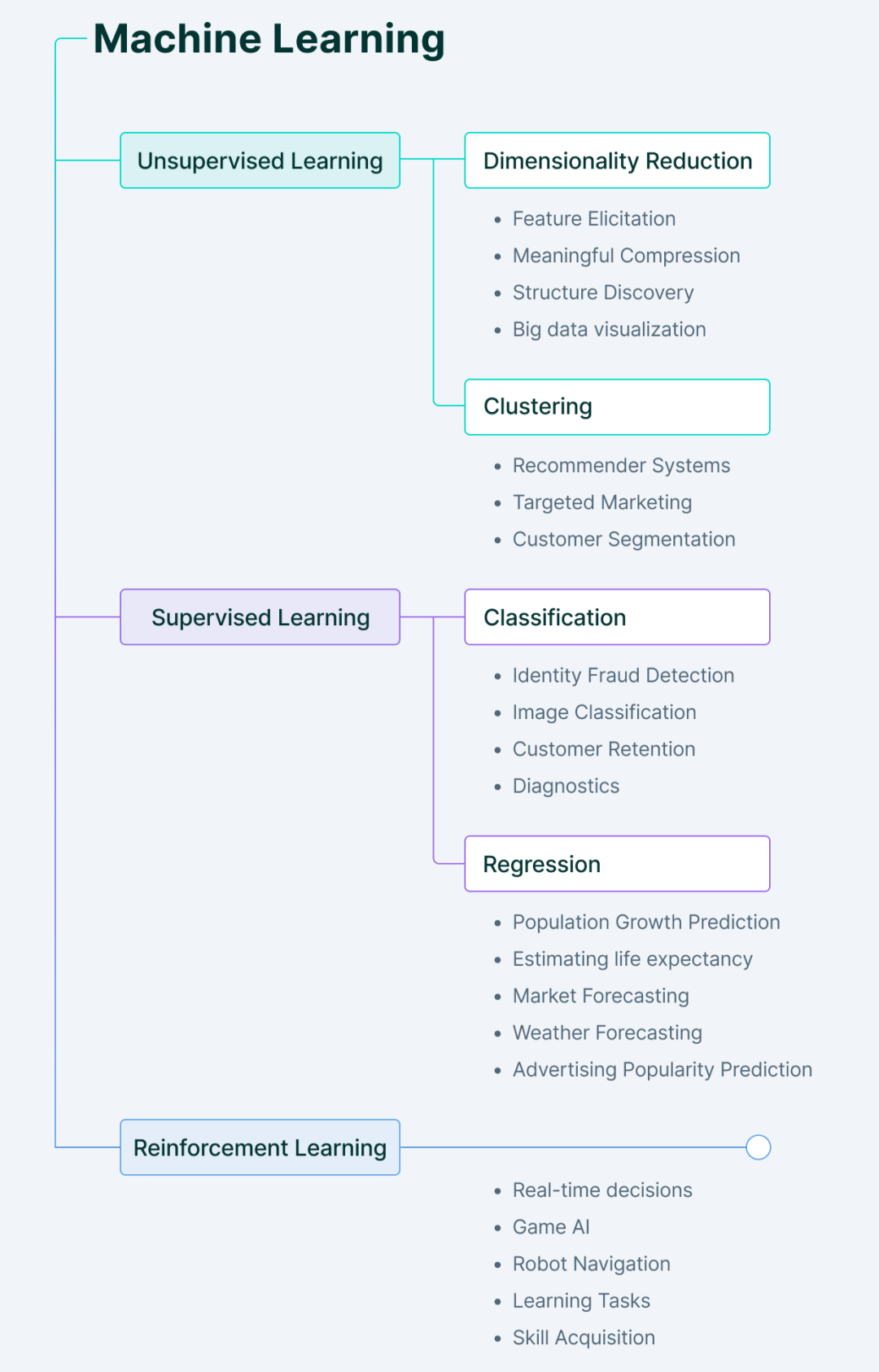
3. Reinforcement Learning
Reinforcement learning involves an agent that learns to behave in its environment by performing actions.
Based on the results of these actions, it provides feedback and adjusts its future course - for every good action, the agent gets positive feedback, and for every bad action, the agent gets negative feedback or punishment.
Reinforcement learning learns without any labeled data. Since there is no labeled data, the agent can only learn based on its own experience.
4. Semi-supervised learning
Semi-supervised is the state between supervised and unsupervised learning.
It takes the positive aspects from each learning, i.e. it uses smaller labeled datasets to guide classification and performs unsupervised feature extraction from larger unlabeled datasets.
The main advantage of using semi-supervised learning is its ability to solve problems when there is not enough labeled data to train the model, or when the data simply cannot be labeled because humans don't know what to look for in it.
Four 6 Real-World Machine Learning Applications
Machine learning is at the core of almost every technology company these days, including businesses like Google or the Youtube search engine.
Below, we have summarized some examples of real-life applications of machine learning that you may be familiar with:
Autonomous vehicles
Vehicles encounter a variety of situations on the road. Such situation.
For self-driving cars to perform better than humans, they need to learn and adapt to changing road conditions and the behavior of other vehicles.

Self-driving cars collect data about their surroundings from sensors and cameras, then interpret it and react accordingly. It uses supervised learning to identify surrounding objects, unsupervised learning to identify patterns in other vehicles, and finally takes action accordingly with the help of reinforcement algorithms.
Image Analysis and Object Detection
Image analysis is used to extract different information from images.
It has applications in areas such as checking for manufacturing defects, analyzing car traffic in smart cities, or visual search engines like Google Lens.
The main idea is to use deep learning techniques to extract features from images and then apply these features to object detection.
Customer Service Chatbot
It’s very common these days for companies to use AI chatbots to provide customer support and sales. AI chatbots help businesses handle high volumes of customer queries by providing 24/7 support, thereby reducing support costs and generating additional revenue and happy customers.
AI robotics uses natural language processing (NLP) to process text, extract query keywords, and respond accordingly.
Medical Imaging and Diagnostics
The fact is this: medical imaging data is both the richest source of information and one of the most complex.
Manually analyzing thousands of medical images is a tedious task and wastes valuable time for pathologists that could be used more efficiently.
But it’s not just time saved—artifacts or small features like nodules may not be visible to the naked eye, leading to delays in disease diagnosis and incorrect predictions. This is why there is so much potential using deep learning techniques involving neural networks, which can be used to extract features from images.
Fraud Identification
As the e-commerce sector expands, we can observe an increase in the number of online transactions and a diversification of available payment methods. Unfortunately, some people take advantage of this situation. Fraudsters in today's world are highly skilled and can adopt new technologies very quickly.
That’s why we need a system that can analyze data patterns, make accurate predictions, and respond to online cybersecurity threats, such as fake login attempts or phishing attacks.
For example, fraud prevention systems can discover whether a purchase is legitimate based on where you made purchases in the past or how long you were online. Likewise, they can detect if someone is trying to impersonate you online or over the phone.
Recommendation Algorithm
This correlation of recommendation algorithms is based on the study of historical data and depends on several factors, including user preferences and interests.
Companies such as JD.com or Douyin use recommendation systems to curate and display relevant content or products to users/buyers.
Five Challenges and Limitations of Machine Learning
Underfitting and Overfitting
In most cases, the cause of poor performance of any machine learning algorithm is Due to underfitting and overfitting.
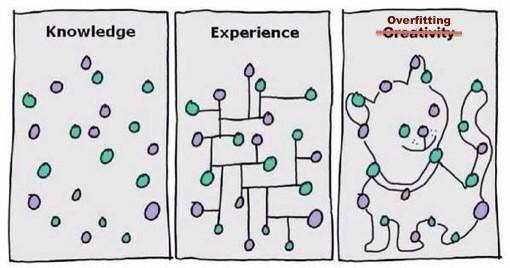
Let’s break down these terms in the context of training a machine learning model.
- Underfitting is a scenario where a machine learning model can neither learn the relationships between variables in the data nor correctly predict new data points. In other words, the machine learning system does not detect trends across data points.
- Overfitting occurs when a machine learning model learns too much from the training data, paying attention to data points that are inherently noisy or irrelevant to the range of the data set. It attempts to fit every point on the curve and therefore remember the data pattern.
Because the model has little flexibility, it cannot predict new data points. In other words, it focuses too much on the examples given and fails to see the bigger picture.
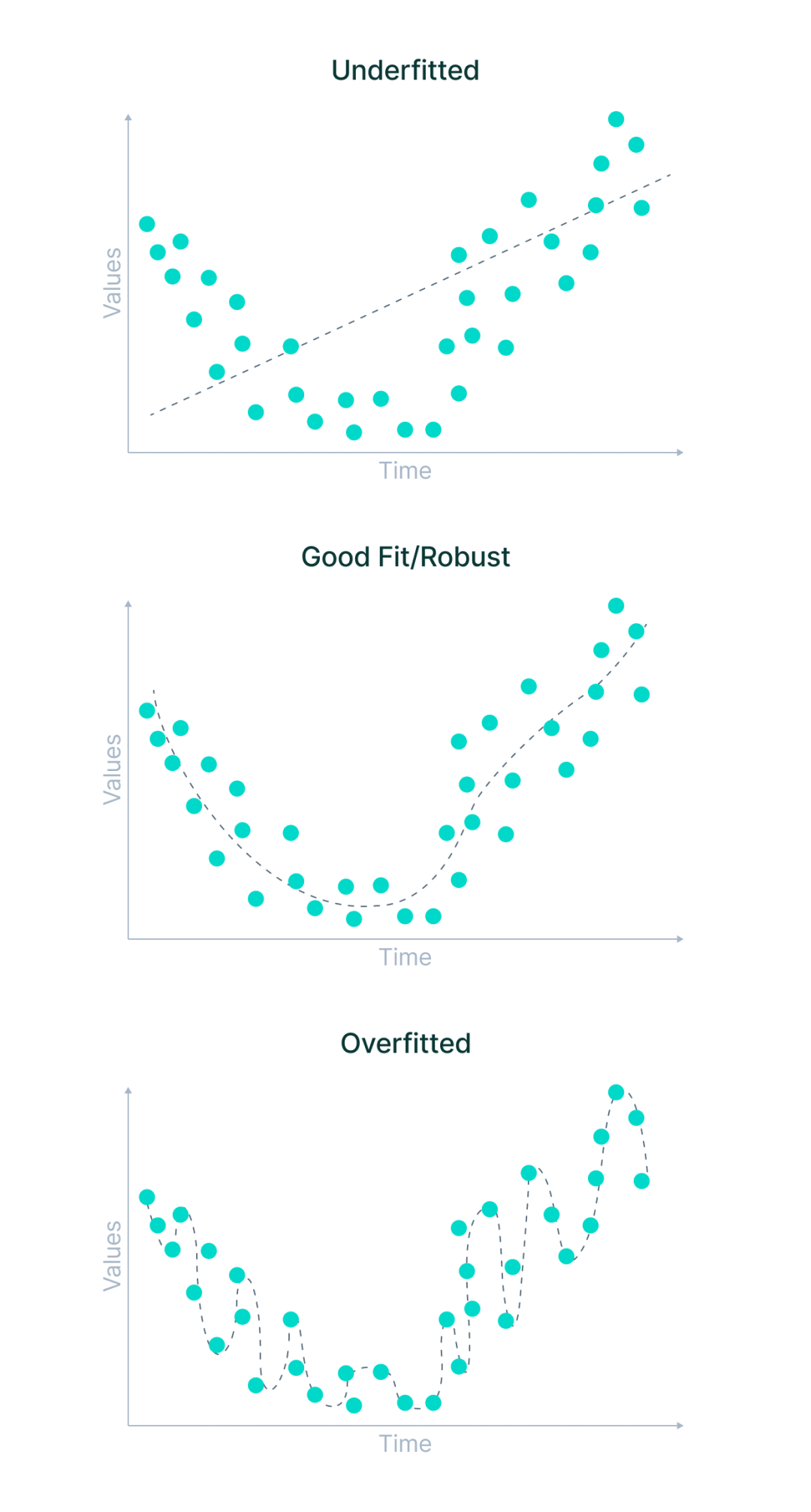
What are the causes of underfitting and overfitting?
More general situations include situations where the data used for training is not clean and contains a lot of noise or garbage values, or the size of the data is too small. However, there are some more specific reasons.
Let’s take a look at those.
Underfitting may occur because:
- The model was trained with the wrong parameters and the training data was not fully observed
- The model is too simple and does not remember enough features
- The training data is too diverse Or complex
Overfitting may occur when:
- The model is trained with the wrong parameters and over-observes the training data
- The model is too complex and not pre-trained on more diverse data.
- The labels of the training data are too strict or the original data are too uniform and do not represent the true distribution.
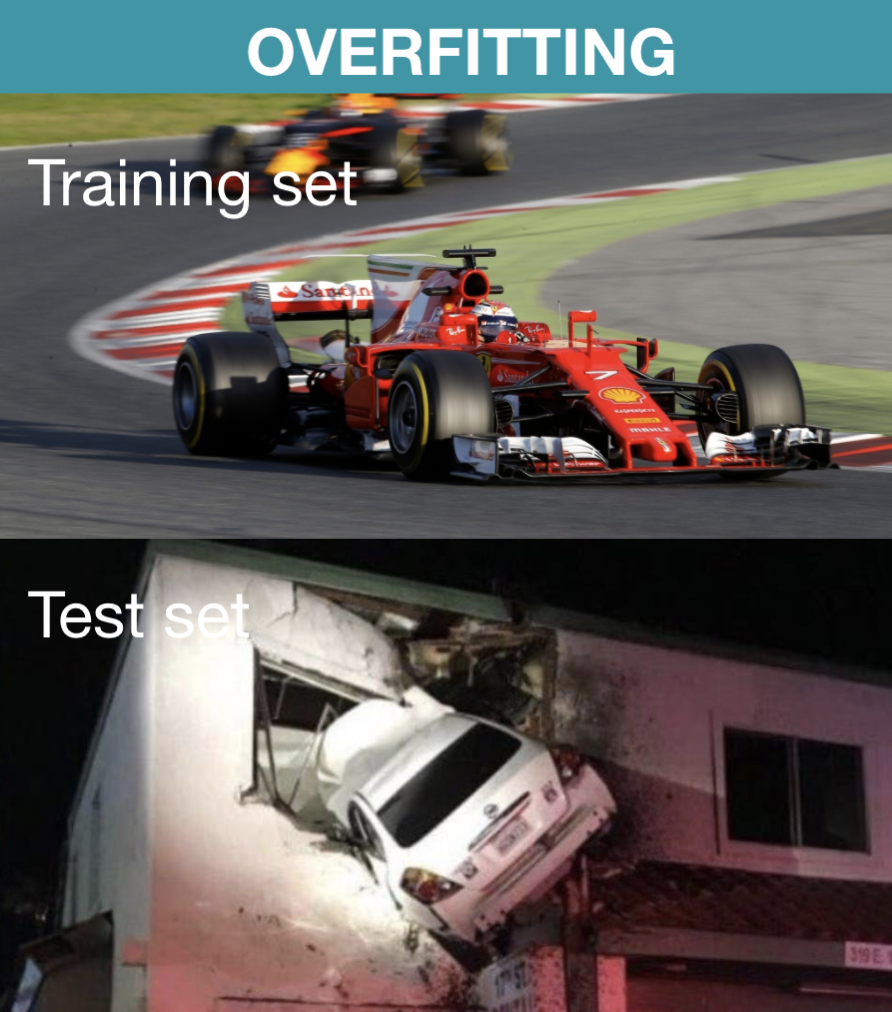
Dimensionality
The accuracy of any machine learning model is directly proportional to the dimensionality of the data set. But it only works up to a certain threshold.
The dimensionality of a data set refers to the number of attributes/features present in the data set. Exponentially increasing the number of dimensions leads to the addition of non-essential attributes that confuse the model, thereby reducing the accuracy of the machine learning model.
We call these difficulties associated with training machine learning models the "curse of dimensionality."
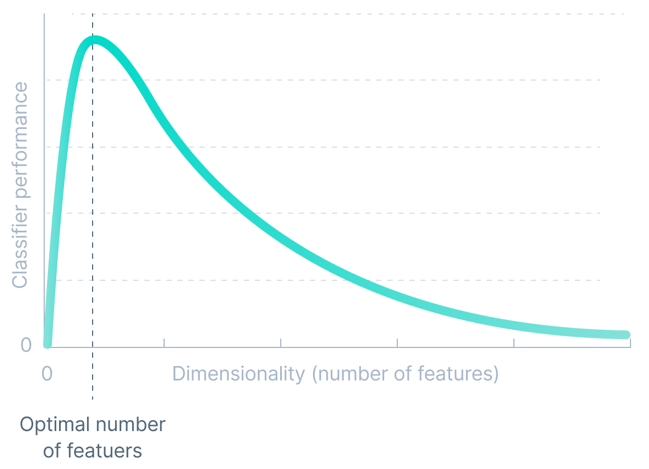
Data quality
Machine learning algorithms are sensitive to low-quality training data.
Data quality may be affected due to noise in the data caused by incorrect data or missing values. Even relatively small errors in the training data can lead to large-scale errors in the system output.
When an algorithm performs poorly, it is usually due to data quality issues such as insufficient quantity/skew/noisy data or insufficient features to describe the data.
Therefore, before training a machine learning model, data cleaning is often required to obtain high-quality data.
The above is the detailed content of Understand what machine learning is in one article. For more information, please follow other related articles on the PHP Chinese website!

Hot AI Tools

Undresser.AI Undress
AI-powered app for creating realistic nude photos

AI Clothes Remover
Online AI tool for removing clothes from photos.

Undress AI Tool
Undress images for free

Clothoff.io
AI clothes remover

Video Face Swap
Swap faces in any video effortlessly with our completely free AI face swap tool!

Hot Article

Hot Tools

Notepad++7.3.1
Easy-to-use and free code editor

SublimeText3 Chinese version
Chinese version, very easy to use

Zend Studio 13.0.1
Powerful PHP integrated development environment

Dreamweaver CS6
Visual web development tools

SublimeText3 Mac version
God-level code editing software (SublimeText3)

Hot Topics
 This article will take you to understand SHAP: model explanation for machine learning
Jun 01, 2024 am 10:58 AM
This article will take you to understand SHAP: model explanation for machine learning
Jun 01, 2024 am 10:58 AM
In the fields of machine learning and data science, model interpretability has always been a focus of researchers and practitioners. With the widespread application of complex models such as deep learning and ensemble methods, understanding the model's decision-making process has become particularly important. Explainable AI|XAI helps build trust and confidence in machine learning models by increasing the transparency of the model. Improving model transparency can be achieved through methods such as the widespread use of multiple complex models, as well as the decision-making processes used to explain the models. These methods include feature importance analysis, model prediction interval estimation, local interpretability algorithms, etc. Feature importance analysis can explain the decision-making process of a model by evaluating the degree of influence of the model on the input features. Model prediction interval estimate
 Implementing Machine Learning Algorithms in C++: Common Challenges and Solutions
Jun 03, 2024 pm 01:25 PM
Implementing Machine Learning Algorithms in C++: Common Challenges and Solutions
Jun 03, 2024 pm 01:25 PM
Common challenges faced by machine learning algorithms in C++ include memory management, multi-threading, performance optimization, and maintainability. Solutions include using smart pointers, modern threading libraries, SIMD instructions and third-party libraries, as well as following coding style guidelines and using automation tools. Practical cases show how to use the Eigen library to implement linear regression algorithms, effectively manage memory and use high-performance matrix operations.
 Five schools of machine learning you don't know about
Jun 05, 2024 pm 08:51 PM
Five schools of machine learning you don't know about
Jun 05, 2024 pm 08:51 PM
Machine learning is an important branch of artificial intelligence that gives computers the ability to learn from data and improve their capabilities without being explicitly programmed. Machine learning has a wide range of applications in various fields, from image recognition and natural language processing to recommendation systems and fraud detection, and it is changing the way we live. There are many different methods and theories in the field of machine learning, among which the five most influential methods are called the "Five Schools of Machine Learning". The five major schools are the symbolic school, the connectionist school, the evolutionary school, the Bayesian school and the analogy school. 1. Symbolism, also known as symbolism, emphasizes the use of symbols for logical reasoning and expression of knowledge. This school of thought believes that learning is a process of reverse deduction, through existing
 Is Flash Attention stable? Meta and Harvard found that their model weight deviations fluctuated by orders of magnitude
May 30, 2024 pm 01:24 PM
Is Flash Attention stable? Meta and Harvard found that their model weight deviations fluctuated by orders of magnitude
May 30, 2024 pm 01:24 PM
MetaFAIR teamed up with Harvard to provide a new research framework for optimizing the data bias generated when large-scale machine learning is performed. It is known that the training of large language models often takes months and uses hundreds or even thousands of GPUs. Taking the LLaMA270B model as an example, its training requires a total of 1,720,320 GPU hours. Training large models presents unique systemic challenges due to the scale and complexity of these workloads. Recently, many institutions have reported instability in the training process when training SOTA generative AI models. They usually appear in the form of loss spikes. For example, Google's PaLM model experienced up to 20 loss spikes during the training process. Numerical bias is the root cause of this training inaccuracy,
 Explainable AI: Explaining complex AI/ML models
Jun 03, 2024 pm 10:08 PM
Explainable AI: Explaining complex AI/ML models
Jun 03, 2024 pm 10:08 PM
Translator | Reviewed by Li Rui | Chonglou Artificial intelligence (AI) and machine learning (ML) models are becoming increasingly complex today, and the output produced by these models is a black box – unable to be explained to stakeholders. Explainable AI (XAI) aims to solve this problem by enabling stakeholders to understand how these models work, ensuring they understand how these models actually make decisions, and ensuring transparency in AI systems, Trust and accountability to address this issue. This article explores various explainable artificial intelligence (XAI) techniques to illustrate their underlying principles. Several reasons why explainable AI is crucial Trust and transparency: For AI systems to be widely accepted and trusted, users need to understand how decisions are made
 Improved detection algorithm: for target detection in high-resolution optical remote sensing images
Jun 06, 2024 pm 12:33 PM
Improved detection algorithm: for target detection in high-resolution optical remote sensing images
Jun 06, 2024 pm 12:33 PM
01 Outlook Summary Currently, it is difficult to achieve an appropriate balance between detection efficiency and detection results. We have developed an enhanced YOLOv5 algorithm for target detection in high-resolution optical remote sensing images, using multi-layer feature pyramids, multi-detection head strategies and hybrid attention modules to improve the effect of the target detection network in optical remote sensing images. According to the SIMD data set, the mAP of the new algorithm is 2.2% better than YOLOv5 and 8.48% better than YOLOX, achieving a better balance between detection results and speed. 02 Background & Motivation With the rapid development of remote sensing technology, high-resolution optical remote sensing images have been used to describe many objects on the earth’s surface, including aircraft, cars, buildings, etc. Object detection in the interpretation of remote sensing images
 Machine Learning in C++: A Guide to Implementing Common Machine Learning Algorithms in C++
Jun 03, 2024 pm 07:33 PM
Machine Learning in C++: A Guide to Implementing Common Machine Learning Algorithms in C++
Jun 03, 2024 pm 07:33 PM
In C++, the implementation of machine learning algorithms includes: Linear regression: used to predict continuous variables. The steps include loading data, calculating weights and biases, updating parameters and prediction. Logistic regression: used to predict discrete variables. The process is similar to linear regression, but uses the sigmoid function for prediction. Support Vector Machine: A powerful classification and regression algorithm that involves computing support vectors and predicting labels.
 Application of algorithms in the construction of 58 portrait platform
May 09, 2024 am 09:01 AM
Application of algorithms in the construction of 58 portrait platform
May 09, 2024 am 09:01 AM
1. Background of the Construction of 58 Portraits Platform First of all, I would like to share with you the background of the construction of the 58 Portrait Platform. 1. The traditional thinking of the traditional profiling platform is no longer enough. Building a user profiling platform relies on data warehouse modeling capabilities to integrate data from multiple business lines to build accurate user portraits; it also requires data mining to understand user behavior, interests and needs, and provide algorithms. side capabilities; finally, it also needs to have data platform capabilities to efficiently store, query and share user profile data and provide profile services. The main difference between a self-built business profiling platform and a middle-office profiling platform is that the self-built profiling platform serves a single business line and can be customized on demand; the mid-office platform serves multiple business lines, has complex modeling, and provides more general capabilities. 2.58 User portraits of the background of Zhongtai portrait construction






